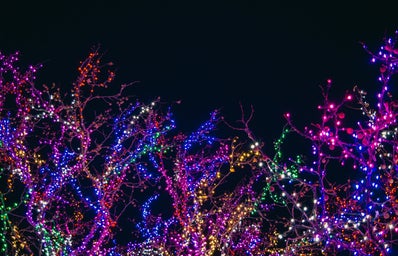I can hear colors, no really. Whenever I tell people this, it’s always hard to explain. The phrase is usually commented as a joke under those ear cleaning videos on TikTok, but for me it is very real. How so? I have synesthesia. This isn’t necessarily a medical impurity but rather a condition of sorts. The textbook definition is “when your brain routes sensory information through multiple unrelated senses, causing you to experience more than one sense simultaneously.” In my case, I experience hearing and sight at the same time but only in a very specific situation: when I am listening to music. For others it could be even more specific, like attributing the days of the week to different colors or experiencing sounds related to seeing things moving. Personally, I thought that my condition was normal for the longest time, so I never talked to anyone about it, thinking everyone had this ability. But now that I know that hearing colors is not a universal thing, I want to share my personal experience with the condition, and how I’ve utilized it in my craft both as a person and an artist.
I can see color with pretty much any kind of music, from normal radio songs to compositions, even a simple string of a melody. To put it into a musician’s terms, as long as there are at least a few bars of music, I should be able to hear some color from it. When I say that I can hear the colors, it isn’t simply that I attach a color to a song simply because of its vibe (ex. blue for sadness or yellow for happy). What really happens is that when I hear a song, a very faint image of a dark room filled with mist and smoke comes into my mind. Once the “correct” color sort of registers in my head, I imagine it like someone turned on a stage light of that color in the room, so the smoke becomes that color. Sometimes it takes me a little bit of time to know what color the song actually is, but usually a few seconds in I’ll be able to grasp it. Interestingly enough, the majority of the songs I hear fall into the primary colors, so red, blue, and yellow, as well as green. Growing up all I had was the radio, and nothing I heard from then ever pushed those boundaries. Now I have more options in terms of where I can listen to music, like YouTube, TikTok, and other media, so my range of colors has slightly expanded. Even with access to a wider variety, the majority of songs that I hear fall within that primary color range. Deviations from that can be orange, which is more common, or purple, which is extremely rare. Neutrals don’t count towards the colors I can hear, like black, white, and brown. I’ve also heard songs where they sound red in the beginning, but then a slight key change in a very specific part of the song made it blue. These songs are, intuitively, red-blue, and I’ve never heard color pairings that have worked like this apart from red and blue. There are artists that are notorious for switching into a completely different key or song altogether in the middle of the song, like Travis Scott, and once the key changes, so does the color. If I were to quantify it that way, then the color of the song is entirely contingent on the key, which is why my ability extends to music without lyrics and instrumentals like game soundtracks or classical music.
The way I learned that not everyone had this was at a piano lesson, where I randomly told my teacher that I could hear colors. The song that we were currently learning sounded green, and when I pointed it out to her, she thought that it was interesting. She asked me if I could hear colors if an individual note was played, or if it was contingent on chords (multiple notes being played at the same time). That was when I found out that my synesthesia was dependent on a string of notes in order to work. Another instance where my ability came up was in an English class, where we were discussing synesthesia as a factor in Robert Frosts’ poems where he likened two senses together and I made the connection to myself. Everyone in my class was really confused until someone asked what “All I Want For Christmas Is You” by Mariah Carey sounded like, which I said sounded blue. Many people disagreed because they thought it would be green, and that told me that I actually hear the color instead of likening it to an aesthetic. In fact, I think of it backwards; the color registers first, and the patterns of aesthetics come together depending on other songs that sound the same color. I’ve noticed that blues can be very happy and upbeat as well as sad, but not in a moody way, more like an introspective way. Reds are sometimes angry, but they’re usually on the cusp of somber and powerful; usually indie songs fit within here. Yellows can be happy, but when they’re orange it’s more reflective and moody. Greens are also happy but in a more toned down and muted way, and a lot of songs that fall into this category are usually a “false happiness” or insanely depressing. It’s also interesting because these patterns are different depending on the genre since many of them tend to fit within specific colors. Jazz is a little special, because it usually falls within yellow and orange, but like a dirty yellow, almost metallic. Pop tends to be bright and neon, while Indie music tends to be muted and neutral. Some artists also have very specific color palettes that tie really well into their aesthetics. For example, Ariana Grande stays within greens and yellows that are either muted or pastel. Lana Del Rey’s music is very red, almost like lipstick shades without the pink. Mitski stays within yellow and green as well, but the tones are much darker and mature as opposed to pastel. So, for me, it’s been interesting to categorize music into these different colors and their shades. I will say, my favorite color both in real life and for music is blue, because it always sounds like raw emotion and range that could never be replicated through words. I also never pay attention to lyrics because of this and tend to favor instrumentals and soundtracks a lot more because I am not told to perceive what I am hearing in a certain way; it’s left to my imagination.
As an artist, doing projects that deal with music has been really fun considering my synesthesia. Recently I redesigned the cover for thank u, next by Ariana Grande and created a record sleeve with A/B side stickers for the record itself as a part of a project. I decided to create a color palette solely based on the colors that all of the songs sounded like on the album, and there were different shades of yellow-orange and green, with the occasional blue and red. Immediately I thought of stained glass and tied that together with a bunch of motifs to create a new album cover. What I thought was interesting was how my preconceptions of how I remembered the album when I first listened to it in 2019 were different from what I heard listening to it now. It allowed me to gain a new perspective on the patterns I had formed based on music that I had listened to so far, since this time around, the songs were much more introspective than I remembered. I knew that this album was personal as it is, but the color palette allowed me to feel it in a sense. This was also the first time I had put the colors down on paper and saw them in real life instead of seeing them in my mind’s eye. That in itself was jarring because it felt like the colors weren’t quite right, and every time I tried to adjust it, I couldn’t quite nail the shade. Despite everything else, this project taught me how unique my ability really was, and how difficult it would be to communicate that to others in a way that made sense to me.
Though there’s more miniscule instances of synesthesia, like Thursday and November are 7 and math is blue, it’s intriguing to see how the senses can meld together and allow our minds to make sense of things in a fascinating way. I’ve always loved my ability to hear colors, since it helps me connect with music more deeply and allows me to appreciate all artist’s work. Recently I’ve noticed what could be another part of my synesthesia, where I’m almost able to read the instrumentals that musicians tend to use as “brushstrokes” or “mediums.” It’s hard to explain (what else is new), but I wouldn’t liken the instrumentals to actual artistic techniques, but rather physical objects or even basic aesthetics. Combined with my current synesthesia, it’s almost like I draw metaphors or motifs from music which allows me to make sense of it, even without any lyrics. I know there’s always discourse over lyrics in music, like who the song is meant for, what the lyrics actually mean, etc. But my ability lets me appreciate the song as it is, the melodies, the harmonies, the instrumentals, and everything in between. Overall, it has been very interesting to have sound-color synesthesia, as it quite literally allows me to hear colors and perceive music on an entirely different level, a level that opens the mind’s eye to the infinite imagination.


